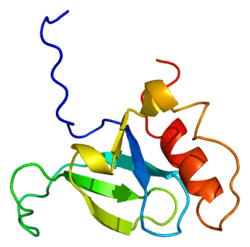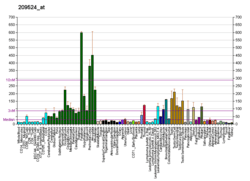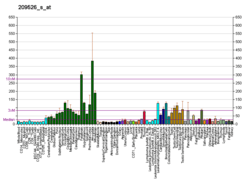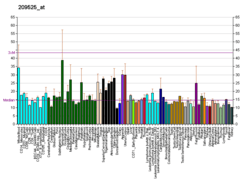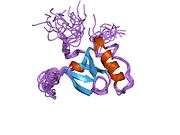HDGFRP3
Hepatoma-derived growth factor, related protein 3, also known as HDGFRP3, is a human gene.[5]
References
Further reading
- Vandegraaff N, Devroe E, Turlure F, et al. (2006). "Biochemical and genetic analyses of integrase-interacting proteins lens epithelium-derived growth factor (LEDGF)/p75 and hepatoma-derived growth factor related protein 2 (HRP2) in preintegration complex function and HIV-1 replication". Virology. 346 (2): 415–26. doi:10.1016/j.virol.2005.11.022. PMID 16337983.
- Barrios-Rodiles M, Brown KR, Ozdamar B, et al. (2005). "High-throughput mapping of a dynamic signaling network in mammalian cells". Science. 307 (5715): 1621–5. doi:10.1126/science.1105776. PMID 15761153.
- Gerhard DS, Wagner L, Feingold EA, et al. (2004). "The Status, Quality, and Expansion of the NIH Full-Length cDNA Project: The Mammalian Gene Collection (MGC)". Genome Res. 14 (10B): 2121–7. doi:10.1101/gr.2596504. PMC 528928. PMID 15489334.
- Cherepanov P, Devroe E, Silver PA, Engelman A (2005). "Identification of an evolutionarily conserved domain in human lens epithelium-derived growth factor/transcriptional co-activator p75 (LEDGF/p75) that binds HIV-1 integrase". J. Biol. Chem. 279 (47): 48883–92. doi:10.1074/jbc.M406307200. PMID 15371438.
- Ota T, Suzuki Y, Nishikawa T, et al. (2004). "Complete sequencing and characterization of 21,243 full-length human cDNAs". Nat. Genet. 36 (1): 40–5. doi:10.1038/ng1285. PMID 14702039.
- Strausberg RL, Feingold EA, Grouse LH, et al. (2003). "Generation and initial analysis of more than 15,000 full-length human and mouse cDNA sequences". Proc. Natl. Acad. Sci. U.S.A. 99 (26): 16899–903. doi:10.1073/pnas.242603899. PMC 139241. PMID 12477932.
- Lai CH, Chou CY, Ch'ang LY, et al. (2000). "Identification of Novel Human Genes Evolutionarily Conserved in Caenorhabditis elegans by Comparative Proteomics". Genome Res. 10 (5): 703–13. doi:10.1101/gr.10.5.703. PMC 310876. PMID 10810093.
- Ikegame K, Yamamoto M, Kishima Y, et al. (2000). "A new member of a hepatoma-derived growth factor gene family can translocate to the nucleus". Biochem. Biophys. Res. Commun. 266 (1): 81–7. doi:10.1006/bbrc.1999.1733. PMID 10581169.
This article is issued from
Wikipedia.
The text is licensed under Creative Commons - Attribution - Sharealike.
Additional terms may apply for the media files.
